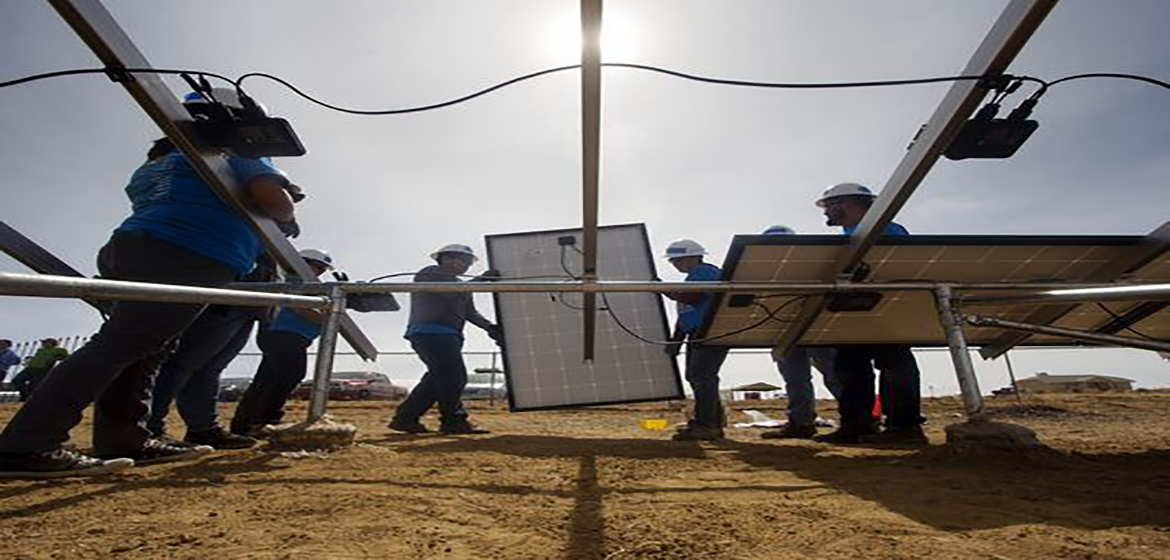By Noel Lyn Smith
STORY HIGHLIGHTS
- A total of 11 students spending spring break installing a solar project at the Ojo Encino Chapter house as part of a nationwide program under GRID Alternatives.
- The group spent last week installing a 32-panel, grid-tied solar unit on the west side of the Ojo Encino Chapter house.
- Ojo Encino is located along the eastern boundary of the Navajo Nation.
OJO ENCINO — Fort Lewis College student Aaron Toledo carefully handled his utility knife while removing the outer layer of plastic from a wire before stepping aside for another student to work.
"This sure feels like peeling potatoes," Toledo said on Wednesday.
His work was inspected by Berlyn Hubler, tribal program coordinator for GRID Alternatives, a nonprofit solar installer based in Oakland, California.
"Is it beautiful? Ah, yeah, Aaron is getting pro now," Hubler said.
Toledo, an engineering student from the Becenti Chapter, was among 11 students spending spring break installing a solar project at the Ojo Encino Chapter house as part of a nationwide program under GRID Alternatives.
This is the fifth year for GRID Alternatives' Solar Spring Break program, which provides college students the opportunity to install solar projects in underserved communities across the country.
The group, which included two faculty members and GRID Alternatives personnel, arrived at the chapter house on March 4 and spent the week installing a 32-panel, grid-tied solar unit on the west side of the chapter house.
Cassandra Valandra, a construction fellow in GRID Alternatives' SolarCorps Fellowship Program, helped four students test the voltage of the solar panels as part of the preparation work.
Valandra, a member of the Rosebud Sioux Tribe in South Dakota, joined SolarCorps to develop skills and to learn about solar energy.
She said her tribe does not have an electric company, so tribal members pay for services supplied from resources off the reservation. But she hopes her interest in alternative energy leads to the development of a service for her tribe.
Gwendolyn Tsosie, an engineering student from the Ganado Chapter in Arizona, helped with the voltage testing. She said the hands-on training has furthered her understanding of what she has read in textbooks and learned in class, but learning about the potential to bring more solar projects to the Navajo Nation has gotten her attention.
"This is the start of something big," she said adding she has heard stories about tribal members struggling to have electricity in their homes.
Tim Willink, director for tribal programs at GRID Alternatives, said the students benefit from participation in the program by learning skills, and they are helping the chapter save money by providing a renewable energy source.
"Instead of going to Vegas or the Caribbean, they're here giving back to the community," Willink said.
"We're exposing these students and other folks to a potential career path in solar. They like working outside and with their hands. They're learning about this technology, that it's something attainable," he said.
Reducing the chapter's electric bill was one reason Chapter Manager Gloria Chiquito contacted Willink after he talked about solar power at a meeting between the Ojo Encino, Counselor and Torreon chapters.
Chiquito said she is interested in seeing how much the chapter saves after its solar system starts operating.
Ojo Encino is located along the eastern boundary of the Navajo Nation. Although 95 percent of homes in the chapter receive electricity supplied by the Jemez Mountains Electric Cooperative Inc., many residents struggle to pay their bill.
"I know a lot of our local people are low income. I know they come to the chapter asking for help, such as when their lights get disconnected," Chiquito said.
By having a solar project at the chapter house, it can serve as a teaching tool for residents to understand how solar works and whether such units can be installed on homes, she said.
This is the first year Fort Lewis College has participated in the spring break program. The idea started after Becky Clausen, an associate professor of sociology, and Laurie Williams, a professor of engineering, learned about the program.
As Williams watched the students, she talked about how the experience is opening their eyes to solar technology and how accessible it is, even to remote areas like Ojo Encino.
"They're thinking critically about what solar could mean to other communities on the reservation and the challenges with issues of net metering or not net metering and who's your service provider," Williams said.
Clausen said the students also have talked about the relationship between solar energy, politics and economics.
"I think having both paired together for this week is going to make them be able to think about how to make change in the future," she said.
Source:
Related to SDG 7: Affordable and clean energy



